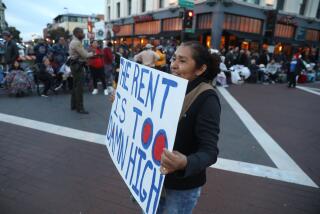Economy’s rebound isn’t waiting for a housing recovery
Let’s say there’s no big rebound in the housing market this year.
So what?
The latest Case-Shiller index of home prices in 20 major U.S. cities, reported this week, showed a drop of 1.6% in November from a year earlier, the second straight such decline.
That resumed a slide that began in 2007 and was only briefly interrupted last spring, when Uncle Sam was handing out $8,000 tax credits to home buyers.
When that program expired, many housing analysts figured that prices and sales would quickly slump again. Which they did.
In December the number of housing starts nationwide fell to a seasonally adjusted annual rate of just 529,000 units, a 14-month low and not much above the 477,000 recorded in April 2009, which was the lowest level in decades.
Yet even as home prices and new construction turned back down, the U.S. economy grew at a 3.2% real annualized rate in the fourth quarter, up from 2.6% in the third quarter and 1.7% in the second.
There are two lessons here, five years into the housing sector’s crash. One is that we should abandon hope for a strong recovery in the market anytime soon, particularly in places like California.
The other lesson is that the American economy as a whole can continue to expand despite a depressed housing sector. It proved as much in the fourth quarter.
Even without a revival of residential real estate, “We’re going to have a growing economy,” said Edward Leamer, director of the UCLA Anderson Forecast.
That’s notable because, historically, housing has led the economy out of recessions. This time, it hasn’t and it won’t. That’s the price we’re paying for the bubble years.
New-home construction accounted for a mere 2.2% of gross domestic product last quarter, compared with 6.1% for all of 2005, before the bubble burst.
But other sectors of the economy are picking up the slack. The most important, consumer spending — which accounts for 70% of GDP — rose at a robust 4.4% annual rate last quarter, up from 2.4% in the third quarter, the government estimated Friday.
Exports grew at an 8.5% rate, an acceleration from 6.8% in the third quarter.
Spending on equipment and software, a gauge of business capital expenditures, rose at a 5.8% rate, though that slowed from 15.4% in the third period.
Still missing, however, is meaningful job growth. And that’s where housing typically has been a huge help coming out of recessions.
Leamer estimates that there are 2 million former construction workers in the ranks of the jobless, as the nation’s unemployment rate remains stuck above 9%.
In part, builders are being victimized far more than they might have expected by the overhang of existing homes in the marketplace, including those in the foreclosure process or heading for it.
Even as housing starts slumped in December, and new-home sales remained severely depressed, sales of existing homes surged to a seasonally adjusted annual rate of 5.28 million units. That was the highest level since spring and up 38% from the post-tax-credit low of 3.84 million in July.
So Americans actually were buying homes in the fourth quarter, taking supply off the market; most of them just weren’t looking for new homes because there are so many choices available from existing stock.
It’s “difficult for new-construction homes to compete with distressed properties,” Michelle Meyer, an economist at Bank of America Merrill Lynch, noted in a report this month. “Foreclosures are priced anywhere from 25% to 60% below voluntary sales, depending on the condition of the home, while ‘short’ sales are priced at a 15% to 20% discount. Although existing homes will often require renovations, it demands less money upfront” than buying a new home.
This is the free market at work. It’s obviously brutal on sellers but is the quickest route to restoring housing to health.
Something else to keep in mind: The sale of an existing home may steal from potential new construction, but it still helps the economy because home buyers often spend on other things besides their house — appliances, curtains, paint, landscaping, etc.
Of course, while buyers finally may be getting bargains in housing, the renewed slide in prices threatens a potential depressant effect on spending as current homeowners see their wealth erode further.
What’s more, a decline in prices that pushed more homeowners underwater on their mortgages, meaning the loan value exceeded the home’s market price, could fuel a new wave of walkaways and more foreclosures.
How to avoid more housing calamity? The fourth-quarter strength in the rest of the economy will have to produce a sustained pickup in job growth. If that finally happens, it will provide the necessary ingredients to stabilize housing demand and, at some point, prices.
More jobs would mean more income and a jump in new households as, for example, young adults now living with their parents move out. Rising payrolls also would give the already employed more confidence to spend money, including on move-up housing.
Eventually, this virtuous cycle would boost new-home construction as the most attractive existing homes get snapped up.
How many jobs will be enough? Nobody believes payrolls are set to explode. The trend is what will be important. Momentum can feed on itself.
As for the new-home market, one argument is that there’s nowhere to go from here but up, which means that residential construction could add to GDP this year, if incrementally.
With housing starts so depressed — an annualized construction pace of just 529,000 units for a country of 312 million people — “it’s an incredibly low bar against which to measure a recovery,” said Michael Darda, chief economist at investment firm MKM Partners in Stamford, Conn.






